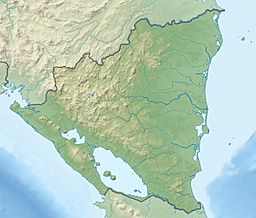Zapatera (archaeological site) facts for kids
Quick facts for kids Zapatera |
|
|---|---|
 |
|
| Highest point | |
| Elevation | 629 m (2,064 ft) |
| Geography | |
Zapatera is a special place in Nicaragua. It is an archaeological site found on Isla Zapatera. This island is a volcanic island located in Lake Nicaragua, within the Granada Department. Many old statues, rock carvings called petroglyphs, and pottery have been discovered here. These finds suggest that Zapatera and the islands around it were important places for ceremonies. They were used by the Chorotega people, an ancient group, between the years 800 and 1350 CE.
Geography of Zapatera Island
Isla Zapatera is a volcano that is no longer active. It stands about 629 meters (2,064 feet) tall. The island covers an area of 52 square kilometers (20 square miles). This makes it the second largest island in Lake Nicaragua, after Ometepe.
Zapatera is located in a calm, shallow part of the lake. This area is known as Charco Muerto, which means "Dead Pond" in Spanish. At its closest point, the island is only about 1 kilometer (0.6 miles) from the mainland. Zapatera and ten smaller islands and islets nearby form a group called the Zapatera archipelago.
Exploring Zapatera's Past
In 1849, an American diplomat and archaeologist named Ephraim George Squier visited Zapatera. He noticed many statues and petroglyphs in an area called Punta de las Figuras.
More than 30 years later, in 1883, Squier's report inspired a Swedish scientist named Carl Bovallius. Bovallius explored the island more deeply. He found 25 statues in a place called Sonzapote. He also discovered many petroglyphs on the small island of La Ceiba.
Later, in the 1930s, Mexican Felipe Pardines wrote articles about the petroglyphs on El Muerto island. The most recent archaeological work happened in the 1980s. These were small digs, but a full study of the island is still needed.
Unfortunately, many ancient items have been taken from Zapatera. This is called looting. Most of the statues have been removed from the island. A large collection is kept safe in the San Francisco Convent Museum in Granada. However, many others are used as decorations in government buildings. Some have even ended up in private collections or museums in other countries.
Amazing Discoveries
The statues, most of the petroglyphs, and pottery found at Zapatera are from between 800 and 1350 CE. These items are linked to the Chorotega people, an ancient culture from Central America. Other discoveries from this time include tools and animal-shaped figurines. These look similar to items found on the mainland. Some petroglyphs and pottery might be even older, dating back to 500 BCE. Others were made around the time Spanish colonies were established.
The most famous finds from Zapatera are the statues. Records show they were carved from dark basalt rock. They were usually between 1 and 2.25 meters (3.3 and 7.4 feet) tall. They were also quite wide, more than 150 centimeters (59 inches) across.
These statues show both humans and animals. Experts believe they might represent important gods or high-ranking people. Most of them are found around earth or stone mounds. They face outwards, suggesting they were part of a special ceremonial area. Some carvings near these sites suggest that important rituals might have taken place there.
See also
 In Spanish: Zapatera (sitio arqueológico) para niños
In Spanish: Zapatera (sitio arqueológico) para niños


